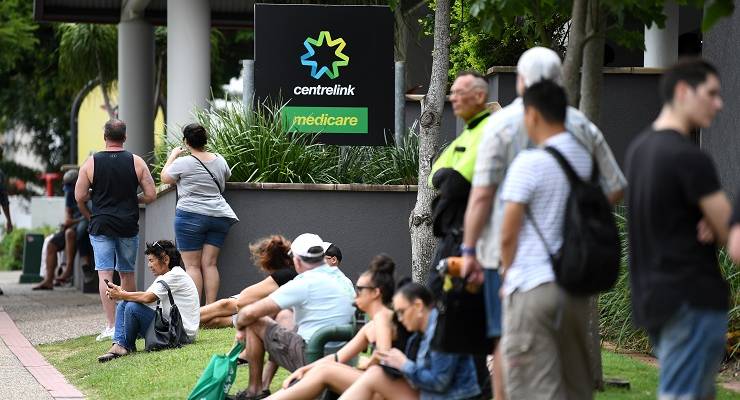
In 2020, Australians may have been, at least ostensibly, “all in this together”. A war-like national mobilisation increased social solidarity, and the federal government reluctantly improved our paltry, patchy welfare state.
Yet we enter 2021 as a society marked by deepening economic cleavages between the haves and have-nots.
Government assistance to the poor is drying up, as is the sense of uncertainty and restraint among the wealthy. New Year’s celebrations were thus tainted with a Gatsby-like hue.
Some Aussies splurged their “COVID savings” with unprecedented zeal after a glum winter. For others, January 1 meant something entirely different: the day their welfare payments were slashed for the second time since their early-pandemic expansion.
While we might technically have left the corona-recession in yesteryear, the lingering effects are likely to “turbocharge” the rich-poor divide.
How unequal was Australia’s economy before the pandemic?
In a word: very.
A report by the Australian Council of Social Services and University of New South Wales found the incomes of the top 20% of Australian earners were six times higher than those of the lowest 20%. The gap widened since 2015-16, when top earners raked in five times more.
The report also found the richest 10% of households owned nearly half of Australia’s private wealth. The “comfortable middle” 30% commanded roughly 38% of wealth, while the lowest 60% owned just 16%. The latter tends to be younger, owing to the growing generational disparity in home ownership.
What did the pandemic do to inequality?
Despite causing the deepest recession in 90 years, the pandemic forced action to temporarily improve inequality. The raising of JobSeeker lifted hundreds of thousands of the most disadvantaged Australians out of poverty, in one of the steepest improvements in recent Australian history.
What governments and NGOs struggled for decades to achieve with more complex and onerous interventions was achieved overnight by simply giving the poor and vulnerable more money.
While some remain ineligible for the expanded payments, such as temporary migrants, multiple studies have found the overall effect was a substantial reduction in overall poverty.
But the government cut the $550 per fortnight coronavirus supplement to $250 in September, despite most economists telling them not to. This pushed over 370,000 recipients back into poverty, according to The Australia Institute.
On New Year’s Day, the supplement was again cut by $100 a fortnight, prompting further concerns from recipients, the social services sector and economists.
The late-December determination by Minister for Social Services Anne Ruston also confirmed the supplement will end altogether in March and cannot be extended again, completing the total clawback of the government’s temporary welfare increases.
What happened to the rich?
They initially tightened their belts as the virus spread, with many stuck in lockdown and concerned about the future.
Their neighbourhoods initially experienced rising unemployment. This was sometimes portrayed as elite suffering, but it was likely due to job losses among a substantial minority of low paid workers, particularly those in entertainment and hospitality, who live in high-rent suburbs due to proximity to their workplaces. They may soon be forced to move, solidifying the gentrification of inner-city areas.
Many middle- and upper-class people working from home also accrued unprecedented savings during the pandemic, as they were unable to spend on restaurant meals, overseas holidays and other luxuries.
The super-rich also did very well from investments, as the stock market increasingly diverged from the real economy. Indeed, the Bloomberg Billionaires Index recorded that the combined wealth of Australian billionaires rose by more than 50% during 2020, after dropping briefly in March.
Now the wealthy and those with savings are splashing cash with renewed abandon. Batten down your fine wines and cheeses.
Whatever happened to Australia’s classless society?
Australia is meaner than most in returning to pre-pandemic levels of welfare support so soon. Even the US narrowly averted a full cessation of enlarged welfare support when the president belatedly signed an extension bill, a few days after millions stopped receiving their cheques.
This isn’t the first time our government has led the world in frugalness. After the Great Depression, our last mega-recession, Australia remained unique among Western nations in worrying excessively about the cost of the response, and thus relegated thousands to impoverishment.
Today, we have again rushed prematurely to parochial stinginess.
Summer holidays, benders and shopping sprees are about to look more gilded age than we’re used to.
Is Australia prepared for its new age of inequality? Let us know your thoughts by writing to letters@crikey.com.au. Please include your full name to be considered for publication in Crikey’s Your Say section.








“…the pandemic forced action to temporarily improve inequality.”
A revealing choice of verb, and a matter of opinion. It is beyond dispute the pandemic forced the government to reduce inequality. But the government rejects any notion this improved it. This government loves inequality.
Surely to improve inequality would increase inequality.?
or somehow enhance the quality of the inequality?
Mmm. Not having a go at the present lot, (but I probably am) but inequality sure seems to follow them and it seems to happen more with them (since Howard) and not as bad as the other mob.
It’s in the Tory DNA to kick people when they’re down.
This is a Government that thrives on inequality!!
Agree Ben. All reviews about the Great Depression response by the Australian Govt are very critical of the Austerity response. Equally, many notable economists were very positive about the GFC response but were critical of the then Labor Govt’s too quick return to a neoliberal driven austerity mindset. So here we go again – ideology beating knowledge/facts. Like ‘flat-earthers’ (the ground is always flat where they stand) the Government’s decision makers are out of touch with other’s reality and can believe ‘others’ are undeserving because they do not try hard enough. ‘Lifters and learners’ anyone?
In the 1930s we relied on the Bank of England for most of our loans.They sent out Sir Otto Niemier to give us our orders Jack Lang tried and Sir Philip Game soon put paid to him.Ted Theodore tried to bring in a Fiduciary Plan and was thwarted by reactionaries in his own party like Joe Lyons who crossed the floor and joined the Tories and finished up prime minister.As a result, Australia suffered arguably the worst of any Commonwealth country with men still sleeping under bridged in 1939 and only the outbreak of World War 2 boosting the economy.
To be fair the ‘response’ was pomy. A principal from the Bank of England (no less!), on the invitation of Scuillin, visited Australia and conducted seminars for Ministers (including State) and insurance and banking groups. Keynesianism did not become respectable until the mid 1940s – and then more by imitation than compensation.
“comprehension” – obviously.
The note that Clark has jotted might do as a programme for a week of Yr8-9 social studies lessons but in the real world recourse to a measuring instrument is required in order for assertions to be taken seriously. Let’s see if there are material changes to the HDI or the Gini from (e.g.) 2018-22
As to monkeying with welfare matters (let’s include Gillard) just where would one begin.
As to national revenue, find or create a graph of Australian exports and Chinese imports from (circa) 2005-2020 overlaid with the derivative (rate of change) of GNP. The penny will drop.
Then again, the Gini coefficient disguises and confuses as much as it reveals about inequality, e.g. see the discussion in Capital by Thomas Piketty.
I am a BIG fan of Piketty and I’m not recommending the Gini in isolation BUT I am RECOMMENDING measurement.
Yet the Gini is a useful instrument and a standard (for better or worse) to evaluate inequality. References available to anyone upon request.